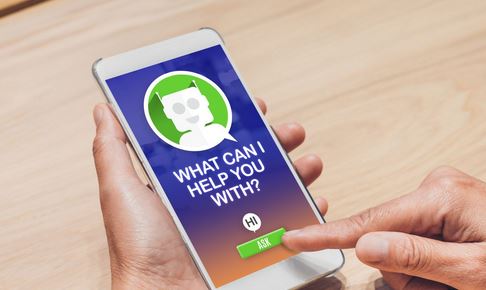That is, programs that can simulate a conversation with a user in natural language through websites or mobile applications, such as Whatsapp, Messenger, Telegram, etc.
Frequently used in customer support services, chatbots work based on in two main tasks:
1) analysis of the user’s request (input), and
2) response to the user’s request (output).
First, the chatbot analyzes the user’s request (eg, charging the mobile phone), identifying their intention and extracting the relevant information to respond to their request (eg, mobile phone number and charge amount).
Second, the chatbot returns a message to the user, which can be based on a generic and predefined text (eg, your mobile phone will be loaded soon), in a contextualized text and adapted to the situation (eg, Mr. X, the your phone with the number Y will be loaded with the balance Z), or even in a clarification question that helps the chatbot to understand the request correctly (eg, do you confirm that you want to load the phone number X with the balance Y? ).
Among the advantages associated with the use of chatbots, we highlight the reduction of costs with human resources, the scalability and availability of service, the automation of processes, the generation of potential customers, the strengthening of the after-sales relationship, among others.
Today, chatbots are present in the most diverse areas and professional sectors, being part of the present and the future of our lives.
However, and regardless of the type of communication approach or platform used, for a chatbot to be effective, human intervention proves to be crucial in terms of its programming and optimization, and there are still countless questions to be answered. In this context, this article presents some of the areas in which chatbots are currently used, as well as the main challenges facing their implementation.
Examples of using chatbots
One of the best ways to understand the potential of chatbots is to know examples of real application cases. Thus, we bring you some of these examples in the area of Education, Health, and Commerce in general.
Education
Chatbots are revolutionizing the way universities and students relate and communicate with each other. Currently, it is already possible, for example, to have programs that present different basic content to students, so that they learn and test their knowledge and skills, evaluating their progress according to a minimum rating or the teacher’s decision. Teachers can monitor student performance and, where appropriate, provide individual plans, analyzing learning needs and recommending content and activities to help students progress.
Its automation also allows assisting the management of repetitive tasks on the part of the teacher or the institution, such as answering general questions about the course, about its general objectives and curricular plan, about the activity plans and evaluations of the curricular units, among others . Some examples of chatbots used to support teaching and learning are Atlanticbot, ClipEscola, or even companies like Google or Microsoft, which already offer solutions in this area.
Cheers
Waiting time is one of the main problems in the National Services . Nobody likes to wait, especially when they are uncomfortable or in pain. It is mainly here that chatbots emerge as an innovative solution at three major levels, managing patient health.
Chatbots can, for example, send photos of test results to family doctors, without the patient having to return to the clinic or hospital, informing him if he needs to take additional care such as medication, treatment, or even the performance new exams.
In terms of counseling and prevention, chatbots can assist patients in clarifying the most basic doubts, or even directing them to a specialty through more judicious screening. In terms of process management,
Trade
The use of chatbots in commerce, in general, covers a huge variety of companies, services and possibilities. In the area of Finance, some banks already offer virtual assistants that help the customer to monitor their payments, to carry out transactions, investments, among others. In the Fashion area, brands like Victoria Secret, H&M, or Sephora, now offer the possibility to find the perfect lingerie, be inspired by an autumn-winter catalog adapted to your preferences, or receive makeup tips before a special occasion. In the area of Tourism, airlines such as KLM, or accommodation services such as Expedia, already allow you to manage different reservations, trips, flights, stays, etc.
Challenges in implementing chatbots
The use of chatbots does not solve all users’ problems, and as any solution based on Artificial Intelligence presents implementation challenges to the most diverse professionals involved, namely Computer Engineers, Designers, or Sales Director. Among these challenges, the following stand out:
Costs
Despite the cost reduction in the hiring of human resources, the initial costs associated with the use of chatbots exist, especially in an initial phase, either in the development of the solution itself, or in the purchase of existing solutions and their adaptation.
While when developing a root solution you will need to hire a team, in the purchase of existing solutions that team will be assured through a subscription. If you choose the first possibility, you will have to think about essential issues such as the business model, the integration between systems and platforms, etc.
Data volume
The accuracy of chatbots is highly dependent on the amount of data they receive. The greater the volume of data, the greater its effectiveness in serving the student, patient or client. For example, solutions of this type will not be recommended for use in the internal management of a small company or organization, as the chatbot may not have enough data due to the limited number of employees (and, in this case, users).
Privacy
Just as the use of social networks or the internet in general does not guarantee user privacy, the use of chatbots also presents challenges in this regard. Once again, the volume of data collected for each user means that chatbots can be a huge and rich source of confidential information. As such, users should be aware that their data is vulnerable to any computer attack or even to the economic interest of those who collect it.
Accessibility
When implementing chatbots, it is necessary to ensure not only that the interface is accessible to all potential users, but also that the interaction follows this same principle. This implies multimodal communication and flexibility. From issues such as language and translation, to integration with braille readers, the use of sign language, etc.
Human sensitivity and emotion
Like any other Artificial Intelligence application, and despite constantly learning from the data they collect, chatbots still sin at the level of human sensitivity and emotion. Especially text-based chatbots, are systems that are ineffective in understanding users’ emotions and consequently deciding on the communication approach to use. That is why a large number of users abandon this type of system after the first interaction.
Synthesis
The benefits that chatbots bring to companies, organizations and users are indisputable. Looking at Education, Health and Commerce in general, this type of solutions based on Artificial Intelligence is revolutionizing the way universities, hospitals, clothing brands, hotels, airlines, students, teachers, patients, and / or customers interact between saving time, reducing costs , obtaining a more personalized experience, etc. Still, chatbots present multiple challenges for those who intend to implement them, such as the initial cost, their degree of accuracy, user privacy, accessibility in terms of the interface, or the very human sensitivity that the system lacks for to communicate.














